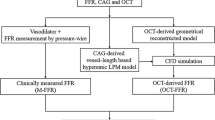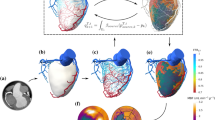Abstract
The temporal and spatial distribution of coronary blood flow, pressure, and volume are determined by the branching pattern and three-dimensional (3-D) geometry of the coronary vasculature, and by the mechanics of heart wall and vascular tone. Consequently, a realistic simulation of coronary blood flow requires, as a first step, an accurate representation of the coronary vasculature in a 3-D model of the beating heart. In the present study, a large-scale stochastic reconstruction of the asymmetric coronary arterial trees (right coronary artery, RCA; left anterior descending, LAD; and left circumflex, LCx) of the porcine heart has been carried out to set the stage for future hemodynamic analysis. The model spans the entire coronary arterial tree down to the capillary vessels. The 3-D tree structure was reconstructed initially in rectangular slab geometry by means of global geometrical optimization using parallel simulated annealing (SA) algorithm. The SA optimization was subject to constraints prescribed by previously measured morphometric features of the coronary arterial trees. Subsequently, the reconstructed trees were mapped onto a prolate spheroid geometry of the heart. The transformed geometry was determined through least squares minimization of the related changes in both segments lengths and their angular characteristics. Vessel diameters were assigned based on a novel representation of diameter asymmetry along bifurcations. The reconstructed RCA, LAD and LCx arterial trees show qualitative resemblance to native coronary networks, and their morphological statistics are consistent with the measured data. The present model constitutes the first most extensive reconstruction of the entire coronary arterial system which will serve as a geometric foundation for future studies of flow in an anatomically accurate 3-D coronary vascular model.
Similar content being viewed by others
References
Baroldi, G., and G. Scomazzoni. Coronary Circulation in the Normal and the Pathologic Heart. Washington, DC: Office of the surgeon general. Department of the Army, 1967.
Bassingthwaighte, J. B., D. A. Beard, and Z. Li. The mechanical and metabolic basis of myocardial blood flow heterogeneity. Basic Res. Cardiol. 96:582–594, 2001.
Beard, D. A., and J. B. Bassingthwaighte. The fractal nature of myocardial blood flow emerges from a whole-organ model of arterial network. J. Vasc. Res. 37:282–296, 2000.
Berne, R., and R. Rubio. Coronary Circulation in Handbook of Physiology, Section2: the Cardiovascular System, Vol. 1: The Heart. Philadelphia, PA: Williams and Wilkins, Baltimore, Maryland, 1979.
Beyar R., R. Caminker, D. Manor, and S. Sidoman. Coronary flow patterns in normal and ischemic hearts Transmyocardial and Artery to Vein distribution. Ann. Biomed. Eng. 21:435–458, 1993.
Bruschke, A., and B. Buis. Anatomy and Pathology of Large Coronary Vessels in Coronary Circulation: From Basic Mechanisms to Clinical Implications. Leiden, The Netherlands: Nijhoff, Boston, MA, 1987.
Bussemaker, J., A. B. Groeneveld, T. Teerlink, M. Hennekes, N. Westerhof, and J. H. van Beek. Low- and high-blood flow regions in the normal pig heart are equally vulnerable to ischaemia during partial coronary stenosis. Pflugers Arch. 434:785–794, 1997.
Chadwick, R. S., A. Tedgui, J. B. Michel, J. Ohayon, and B. I. Levy. Phasic regional myocardial inflow and outflow: Comparison of theory and experiments. Am. J. Physiol. 258:H1687–H1698, 1990.
Decking, U. K., and J. Schrader, Spatial heterogeneity of myocardial perfusion and metabolism. Basic Res. Cardiol. 93:439–445, 1998.
Fulton, W. Morphometry of the Myocardial Microcirculation in Microcirculation of the heart: Theoretical and Clinical Problems. Berlin: Springer-Verlag, 1982.
Gray, H., P. L. Williams, and L. H. Bannister. Gray's Anatomy: The Anatomical Basis of Medicine and Surgery. New York: Churchill Livingstone, 1995.
Grayson, J. Functional Morphology of the Coronary Circulation in The Coronary Artery. New York: Oxford University Press, 1982.
Hoffman, J. I. Heterogeneity of myocardial blood flow. Basic Res. Cardiol. 90:103–111, 1995.
Huyghe, J. M., C. W. Oomens, and D. H. van Campen. Low Reynolds number steady state flow through a branching network of rigid vessels II. A finite element mixture model. Biorheology 26:73–84, 1989.
Huyghe, J. M., C. W. Oomens, K. H. van Campen, and R. M. Heethaar. Low Reynolds number steady state flow through a branching network of rigid vessels: I. A mixture theory. Biorheology 26:55–71, 1989.
Ingber, L. Simulated annealing: Practice versus theory. J. Math. Comput. Model. 18:29–57, 1993.
Izumi, T., M. Yamazoe, and A. Shibata. Three-dimensional characteristics of the intramyocardial microvasculature of hypertrophied human hearts. J. Mol. Cell Cardiol. 16:449–457, 1984.
James, T. Anatomy and Pathology of Small Coronary Arteries in Coronary Circulation: From Basic Mechanisms to Clinical Implications: Leiden, The Netherlands: Nijhoff, 1987.
James, T. N. Anatomy of the Coronary arteries. New York: P. B. Hoeber, 1961.
Kaimovitz, B. Stochastic Morphometric Reconstruction of The Pig's Coronary Tree. MSc Thesis, Technion: Israel Institute of Technology, 2001.
Karch, R., F. Neumann, M. Neumann, and W. Schreiner. Staged growth of optimized arterial model trees. Ann. Biomed. Eng. 28:495–511, 2000.
Kassab, G. S. Morphometry of the Coronary Vasculature in the Pig. PhD Dissertation. San Diego: University of California, 1990.
Kassab, G. S., C. A. Rider, N. J. Tang, and Y. C. Fung. Morphometry of pig coronary arterial trees. Am. J. Physiol. 265:H350–H365, 1993.
Kassab, G. S., D. H. Lin, and Y. C. Fung. Morphometry of pig coronary venous system. Am. J. Physiol. 267:H2100–H2113, 1994.
Kassab, G. S., and Y. C. Fung. Topology and dimensions of pig coronary capillary network. Am. J. Physiol. 267:H319–H325, 1994.
Kassab, G. S., J. Berkley, and Y. C. Fung. Analysis of pig's coronary arterial blood flow with detailed anatomical data. Ann. Biomed. Eng. 25:204–217, 1997.
Kassab, G. S., E. Pallencaoe, A. Schatz, and Y. C. Fung. Longitudinal position matrix of the pig coronary vasculature and its hemodynamic implications. Am. J. Physiol. 273:H2832–H2842, 1997.
Klocke, F. J., R. E. Mates, J. M. Canty Jr., and A. K. Ellis. Coronary pressure-flow relationships. Controversial issues and probable implications. Circ. Res. 56:310–323, 1985.
Kresh, J. Y., M. Fox, S. K. Brockman, and A. Noordergraaf. Model-based analysis of transmural vessel impedance and myocardial circulation dynamics. Am. J. Physiol. 258:H262–H276, 1990.
McAlpine, W. Heart and Coronary Arteries: An Anatomical Atlas for Clinical Diagnosis, Radiological Investigation, and Surgical Treatment. New York: Springer-Verlag, 1975.
Mittal, N., Y. Zhou, S. Ung, C. Linares, S. Molloi and G. S. Kassab. A Computer reconstruction of the entire coronary arterial tree based on detailed morphometric data. Ann. Biomed. Eng. 33(8):1015–1026, 2005.
Nielsen, P. M., I. J. Le Grice, B. H. Smaill, and P. J. Hunter. Mathematical model of geometry and fibrous structure of the heart. Am. J. Physiol. 260:H1365–H1378, 1991.
Qian, H., and J. B. Bassingthwaighte. A class of flow bifurcation models with lognormal distribution and fractal dispersion. J. Theor. Biol. 205:261–268, 2000.
Reneman, R. S., and T. Arts. Dynamic capacitance of epicardial coronary arteries in vivo. J. Biomech. Eng. 107:29–33, 1985.
Smith, N. P., A. J. Pullan, and P. J. Hunter. Generation of an anatomically based geometric coronary model. Ann. Biomed. Eng. 28:14–25, 2000.
Spaan, J. A. Coronary diastolic pressure-flow relation and zero flow pressure explained on the basis of intramyocardial compliance. Circ. Res. 56:293–309, 1985.
Spaan, J. A., A. J. Cornelissen, C. Chan, J. Dankelman, and F. C. Yin. Dynamics of flow, resistance, and intramural vascular volume in canine coronary circulation. Am. J. Physiol. Heart Circ. Physiol. 278:H383–H403, 2000.
Streeter, D. J. Gross Morphometry and Fiber Geometry of the Heart in Handbook of Physiology, Section2: The Cardiovascular System, Vol. 1: The Heart. Philadelphia, PA: Williams and Wilkins, 1979.
Tanaka, A., H. Mori, E. Tanaka, M. U. Mohammed, Y. Tanaka, T. Sekka, K. Ito, Y. Shinozaki, K. Hyodo, M. Ando, K. Umetani, K. Tanioka, M. Kubota, S. Abe, S. Handa, and H. Nakazawa. Branching patterns of intramural coronary vessels determined by microangiography using synchrotron radiation. Am. J. Physiol. 276:H2262–H2267, 1999.
Van Bavel, E. Metabolic and Myogenic Control of Blood Flow Studied on Isolated Small Arteries. PhD Dissertation, University of Amsterdam, 1989.
Van Bavel, E., and J. A. Spaan. Branching patterns in the porcine coronary arterial tree. Estimation of flow heterogeneity. Circ. Res. 71:1200–1212, 1992.
Van Beek, J. H., J. B. Bassingthwaighte, and S. A. Roger. Fractal networks explain regional myocardial flow heterogeneity. Adv. Exp. Med. Biol. 248:249–257, 1989.
Van Beek, J. H., S. A. Roger, and J. B. Bassingthwaighte. Regional myocardial flow heterogeneity explained with fractal networks. Am. J. Physiol. 257:H1670–H1680, 1989.
Vis, M. A., P. Sipkema, and N. Westerhof. Modeling pressure-flow relations in cardiac muscle in diastole and systole. Am. J. Physiol. 272:H1516–H1526, 1997.
Wang, C., J. B. Bassigthwaighte, L. J. Weissman. Bifurcating distributive system using Monte Carlo method. Math. Comput. Model. 16:91–98, 1992.
Weaver, M. E., G. A. Pantely, J. D. Bristow, and H. D. Ladley. A quantitative study of the anatomy and distribution of coronary arteries in swine in comparison with other animals and man. Cardiovasc. Res. 20:907–917, 1986.
Zamir, M. Nonsymmetrical bifurcations in arterial branching. J. Gen. Physiol. 72:837–845, 1978.
Zamir, M., and N. Brown. Arterial branching in various parts of the cardiovascular system. Am. J. Anat. 163:295–307, 1982.
Zamir, M., S. M. Wrigley, and B. L. Langille. Arterial bifurcations in the cardiovascular system of a rat. J. Gen. Physiol. 81:325–335, 1983.
Zamir, M., S. Phipps, B. L. Langille, and T. H. Wonnacott. Branching characteristics of coronary arteries in rats. Can. J. Physiol. Pharmacol. 62:1453–1459, 1984.
Zamir, M. Flow strategy and functional design of the coronary network in. Tokyo; New York: Springer-Verlag, 1990.
Zamir, M. On fractal properties of arterial trees. J. Theor. Biol. 197:517–526, 1999.
Zamir, M. Arterial branching within the confines of fractal L-system formalism. J. Gen. Physiol. 118:267–276, 2001.
Zhou, Y., G. S. Kassab, and S. Molloi. On the design of the coronary arterial tree: A generalization of Murray's law. Phys. Med. Biol. 44:2929–2945, 1999.
Author information
Authors and Affiliations
Corresponding author
Rights and permissions
About this article
Cite this article
Kaimovitz, B., Lanir, Y. & Kassab, G.S. Large-Scale 3-D Geometric Reconstruction of the Porcine Coronary Arterial Vasculature Based on Detailed Anatomical Data. Ann Biomed Eng 33, 1517–1535 (2005). https://doi.org/10.1007/s10439-005-7544-3
Received:
Accepted:
Issue Date:
DOI: https://doi.org/10.1007/s10439-005-7544-3




